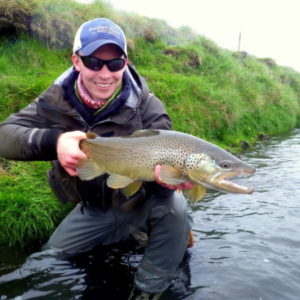Cuba is the Caribbean’s largest island, and its extensive shores provide some of the best saltwater fly fishing for bonefish, permit and tarpon. Being such a vast country, with fishing on all sides one of the difficulties a travelling angler will face is where to start. Faced with this dilemma, I decided that I would head for the enticing option of Jardines de la Reina, the Gardens of the Queen, on the southeastern edge of Cuba. The now national park was named by Christopher Columbus to honour the Queen of Spain, Isabella I of Castile, and has for nearly 30 years been shaped as an international fishing destination.
Since its beginnings in the early 1990s, the fishery has been ever evolving as the operation and guide teams have learnt the areas secrets and the best ways to manage the area for both the benefit of the angler but more importantly the rich and diverse ecosystem. The saltwater flats and mangrove lagoons are famed for their enviable bonefish, permit and tarpon captures, and are divided into three fishing zones. These zones are rested and rotated throughout the season with skiff numbers capped regardless of whether one or all three motherships are operating from week to week.
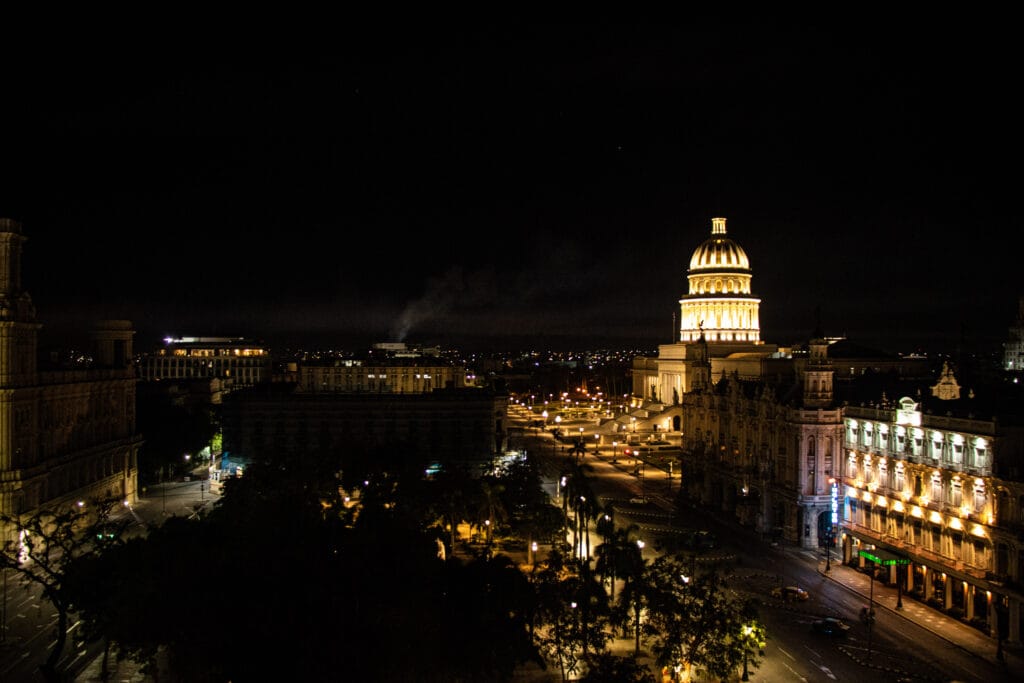
Before any fishing could begin though, my group of happy anglers and I began our trip in Havana. An impressive city, and one that displays extremes in almost all respects. The stunning Baroque and neoclassical architecture is steadily falling into to disrepair, but this is part of the city’s charm. The daily struggles of the Cuban people plays a huge influence in their art, be that their paintings or their wonderful music, both of which can be experienced with almost every step you take. Despite the poverty, and the touting for business one rarely feels unsafe walking through the streets.
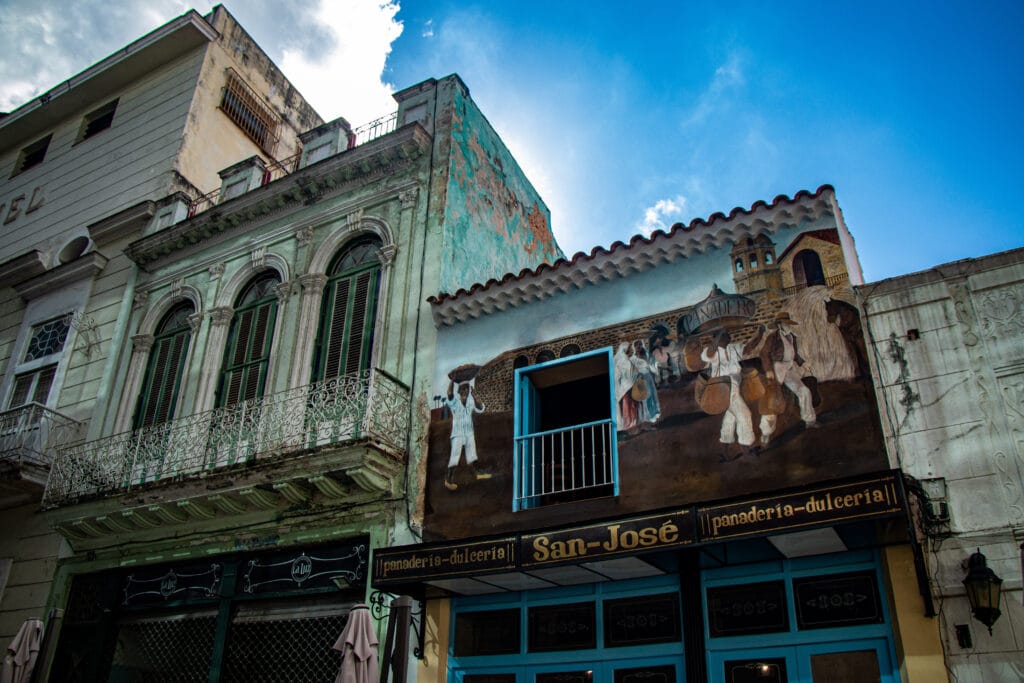
Whether exploring the streets of Old Havana on foot or taking a ride in one of the classic American cars, there is much to enjoy in the city. There are numerous cafés, bars and restaurants that one can visit. Each with its own unique Cuban flair, amazing resourcefulness due to the limited supply of goods and produce, and usually a great acoustic band performance too.
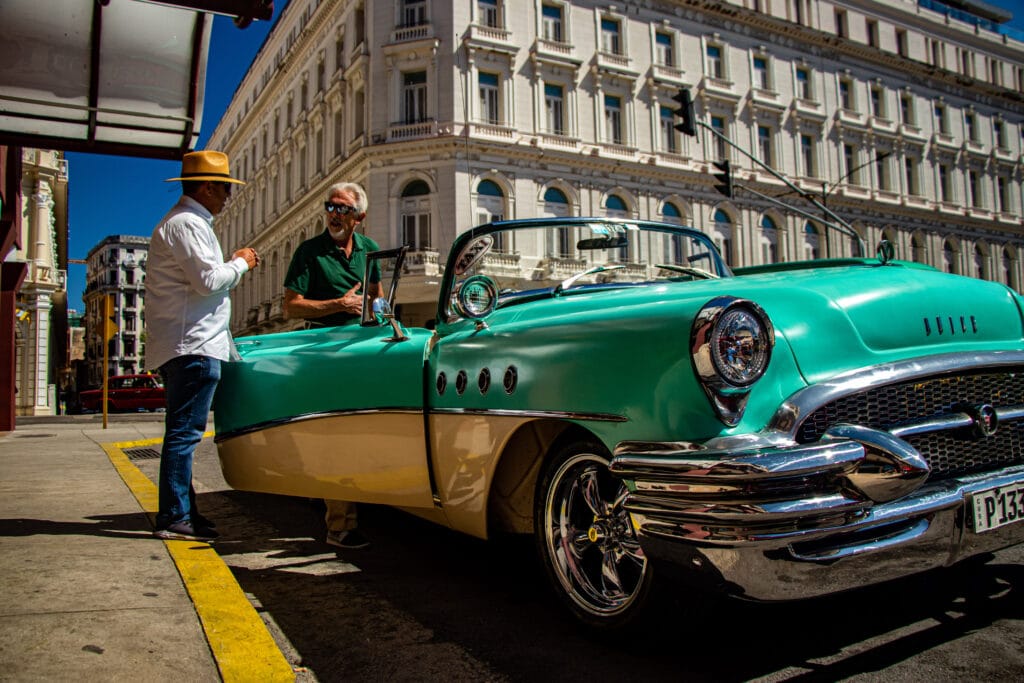
With Havana explored, it was time to hit the road and head to the small port of Jucaro. It is not a swift journey, taking some 7 hours in total (with rum and cigar stops) mainly along the Autopista Nacional, an impressive road constructed in the late 1970s and 80s but with little maintenance since then! The last few moments of the journey takes you through the dusty streets of the port town before entering the harbour compound and a first look at the impressive Jardines motherships. For those who want a shorter road transfer, it is possible to fly into Cayo Coco and travel two hours by road.
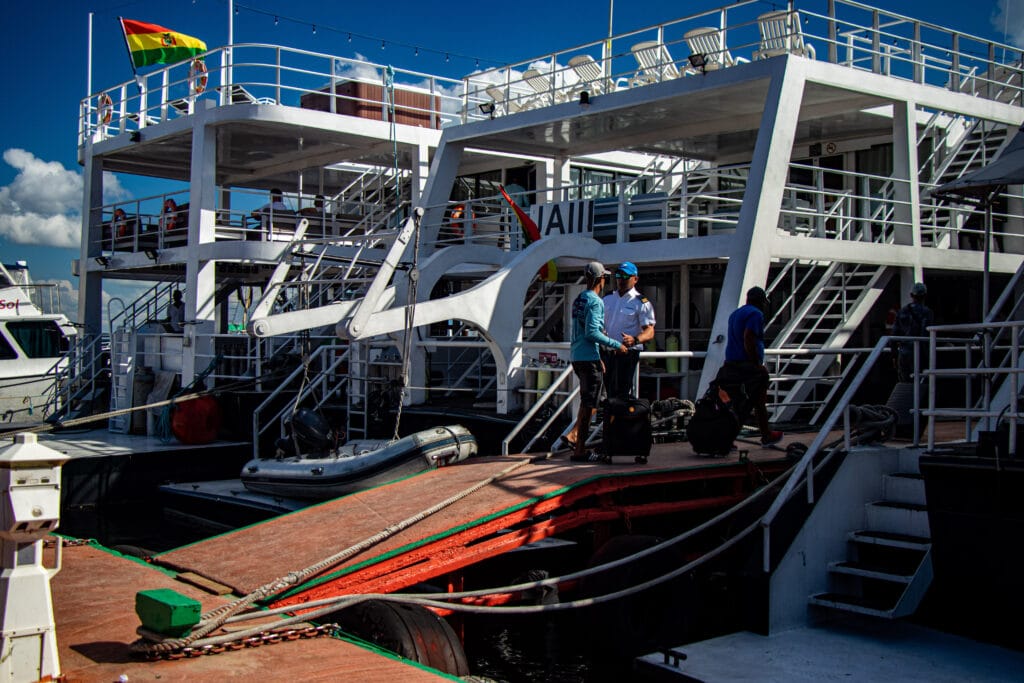
Our home for the next week was to be the Jardines Avalon III, an impressive 160 Foot luxury motor yacht with 15 guest rooms, an air-conditioned lounge and tackle storage are on the main deck, dining area with bar on the upper deck, topped off with a shaded upper sun deck with wet bar and jacuzzi. It was a great base for the week, with a continuous flow of mojitos, beer and great food. The staff aboard were fantastic, led by Captain Luis Miguel, and hostesses Suli and Jamie.
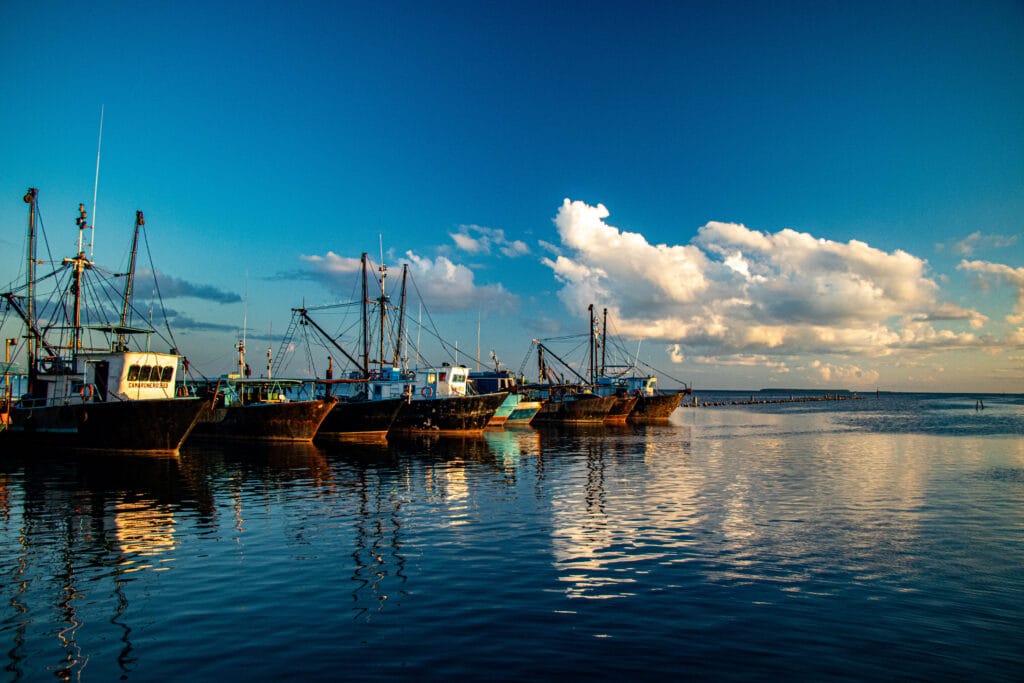
During the afternoon in port, we were given a full briefing before the guide team came to meet the anglers. All the anglers were assisted with setting up for the week, a chance to enjoy the hot Caribbean sun, a cold drink and stir up excitement for the fish that we might encounter in the days ahead. Never one to leave a stone unturned, I strung up four outfits for the week:
For bonefish: 9 foot #8 Guideline LPX Coastal with Guideline Halo #8/9 and the Airflo Superflo Ridge 2.0 Flats Universal Taper WF8F
For permit: 9 foot #9 Guideline Stoked with Guideline Vosso #7/9 and the Airflo Superflo Ridge 2.0 Flats Universal Taper WF9F
For baby tarpon: 9 foot #10 Guideline LPX Coastal with Guideline Vosso #9/11 and the older Airflo Tarpon Taper WF10F
General species: 9 foot #12 Guideline LPX Coastal with Guideline Vosso #11/13 and the Airflo Superflo Ridge 2.0 Flats Universal Taper WF12I
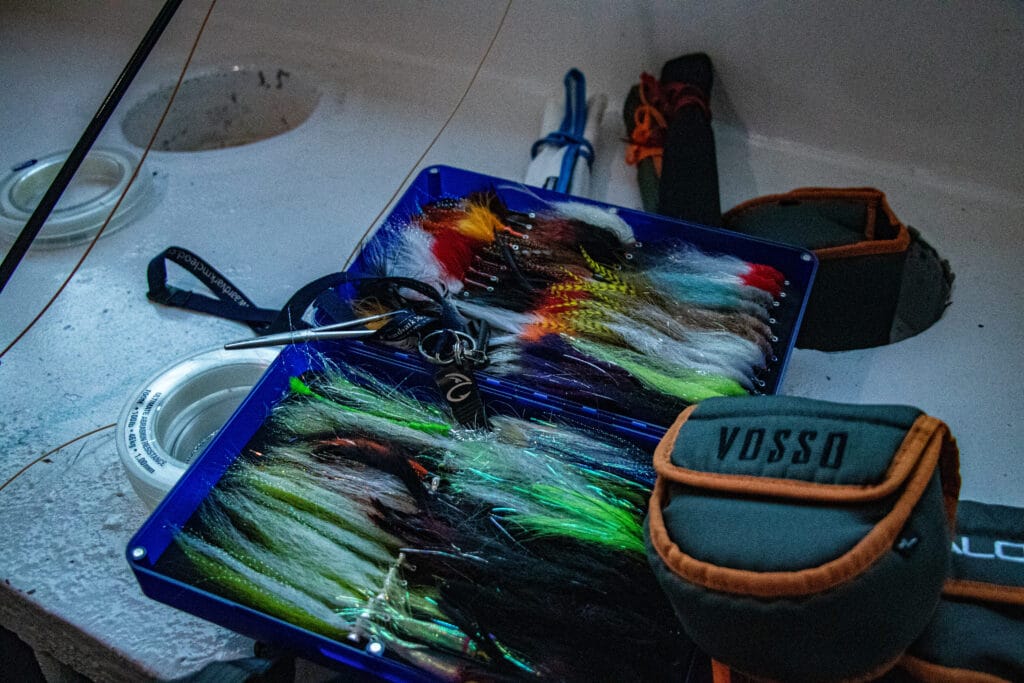
Once fully settled in, the dinner bell was rung, and we sat down to enjoy our first meal aboard JA-III provided by chefs Josiel and Patis. During the meal the captain fired up the engines and we began the four-hour sail to our mooring location within the Jardine de la Reina archipelago. The crossing was smooth and passed by almost unnoticeably except for the gentle whirring of the ships engines. Most of the group had retired to their cabins shortly after reaching our destination, keen to get a good night’s rest before the 0630 breakfast.
Waking up early, I found my way to the coffee machine – a morning necessity for me. Fresh cup in hand, I enjoyed the warm breeze from the sun deck although still shrouded in darkness. Feeling more awake I joined the anglers as they too emerged for the breakfast still with little natural light. During the frenzied eating night gave way to day within moments. Light comes fast this close to the equator, and within no time at all light had sprung all around showing our new water world with dotted mangrove forests.
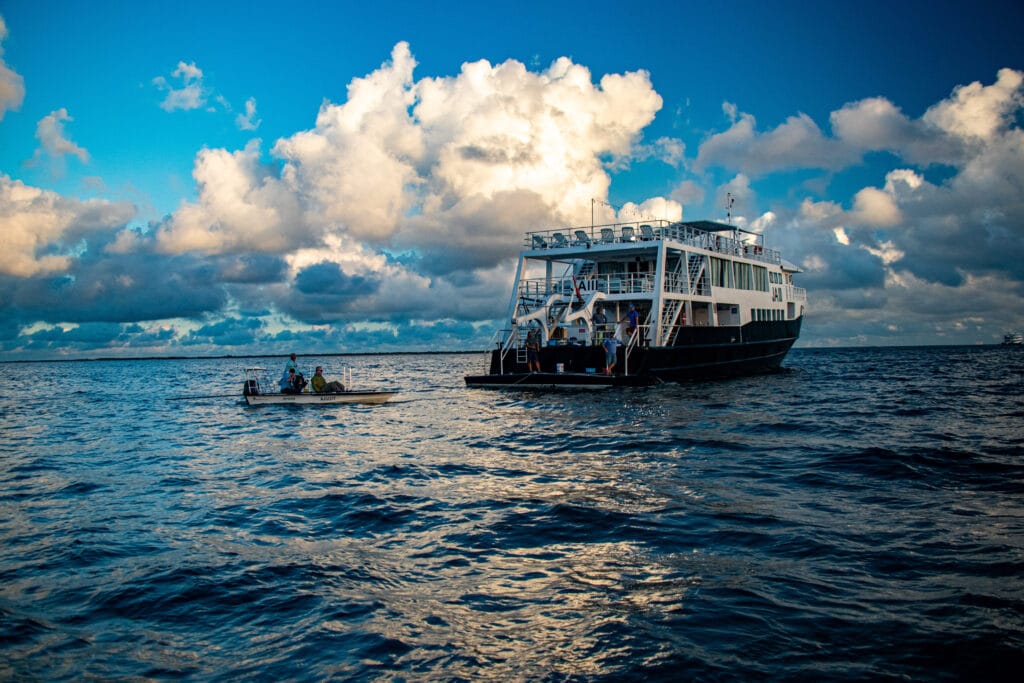
Descending to the main deck it was not long before the guides were buzzing towards the ship in their Dolphin Skiffs from an unseen hideaway location in the mangroves. Each skiff, with centre console, poling platform at the back and a large casting desk up front with lean bar too. Joining forces with Stephen and guide Nelson, we hit the water.
It is always best to go with the flow on the first day, of course you should express your preferred fishing but also ask what the guide thinks. As was the form for the week, the first couple of hours was spent targeting tarpon along the mangrove edges. With the light still relatively dull, it was a great time to look for the silver and splash of rolling fish. That first day we seemed to drop on to pods of fish in every spot we tried. After the first hour, we had achieved a 100% hook up and land ratio on three reasonable baby tarpon to 10 lbs, the fish enjoying the Fulling Mill Millhouse Tarpon Toad Black Death.
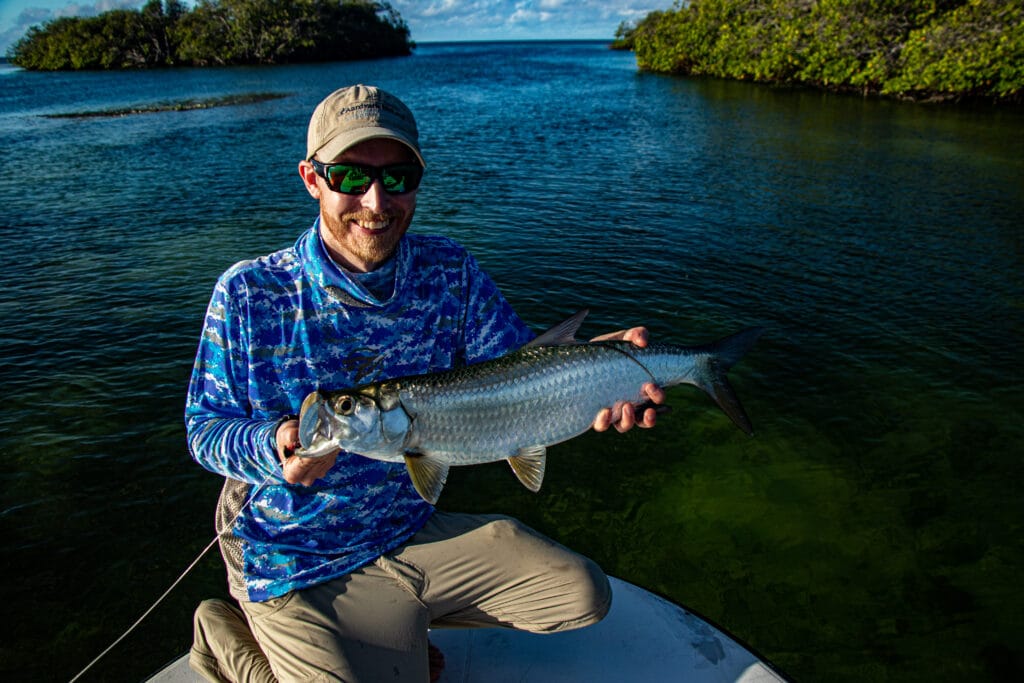
As the tide dropped towards a 10am low we headed out to a broad beach flat, still with tarpon in mind. The fish come into these shallow bays to hunt out sardines. In the clear water we had fleeting shots at some small schools of tarpon, seemingly a slightly bigger average size to those in the mangroves. Despite no more tarpon hook ups, I had a thrilling smash take and acrobatic fight from a barracuda with the fly thankfully dropping out when we landed the fish! Stephen then found himself going toe to toe with a feisty yellow tail jack that enjoyed stripped line well into the backing on several occasions. The flat had one more surprise for us, as a large permit sauntered by with little interest in our tarpon flies… the only rod to hand at the time!
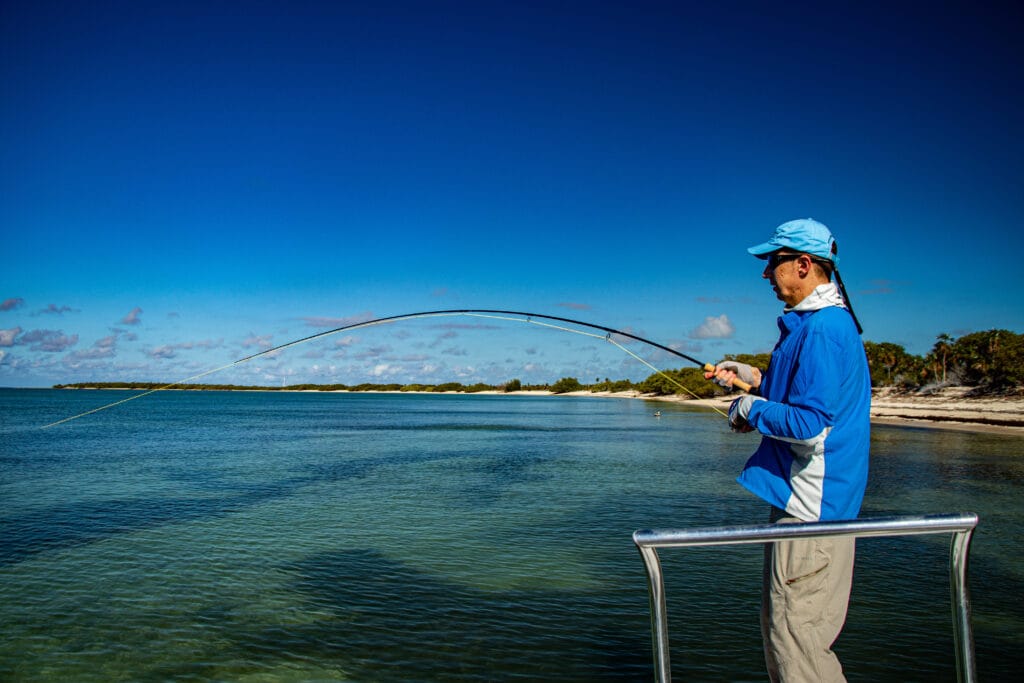
To see us through to lunch, we chased a school of mudding bonefish on a huge marly flat on the inside of the mangroves. Each fresh cloud of mud we reached we were already too late as the grey ghosts had moved to a new spot. Eventually I hooked up, at first, I thought I had a small snapper only to realise I had my first Cuban bonefish… and one of my smallest too!
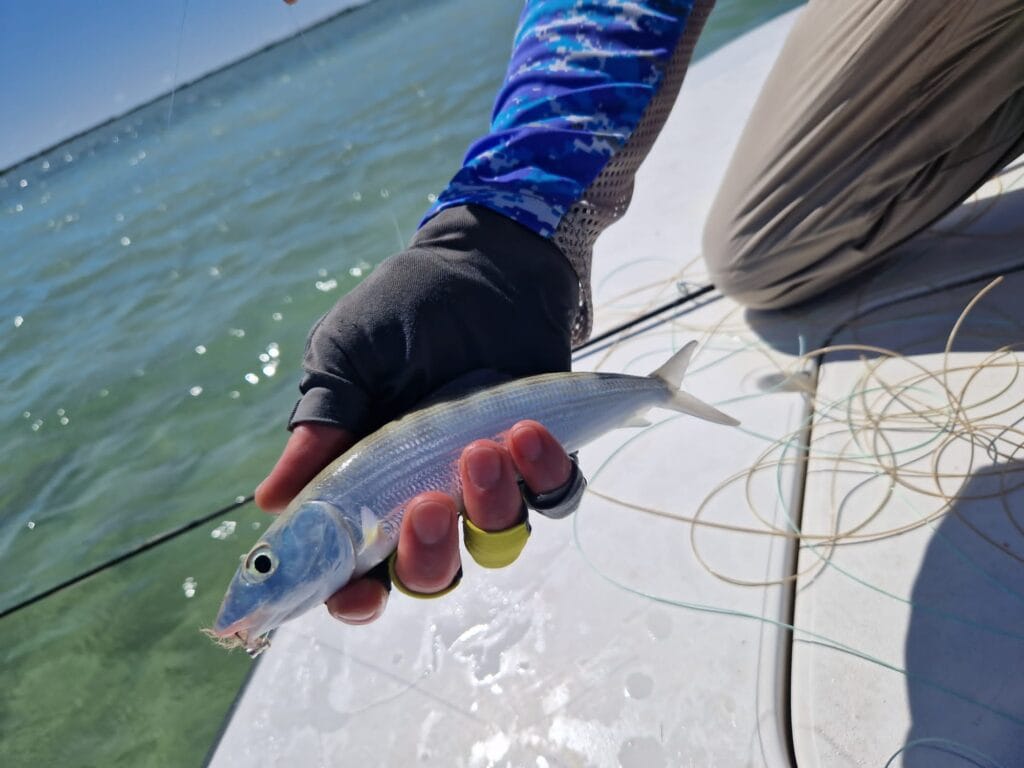
After a quick lunch stop in the welcome shade of the mangroves, we headed back out. Sticking with bonefish, we headed to the southern edges of the mangroves and the vast turtle grass flats. The tide was flooding now, and we found numerous schools of good-sized bonefish trying the inch their way up to the freshly submerged ground to feed. Glistening tails could be seen twitching as they ferreted around on the bottom. Dark shadows glided over the gently swaying weed. Both Stephen and I enjoyed hooking several chunky bonefish between 3 and 6 lbs.
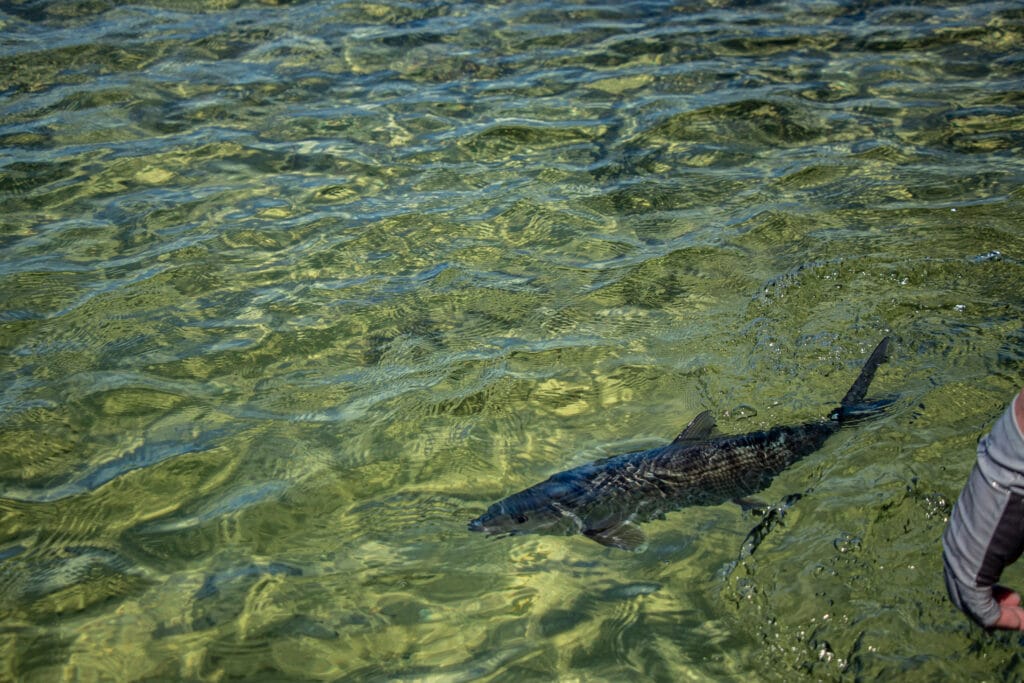
For the remainder of the day, we changed tack and targeted permit under the watchful gaze of ospreys and great egrets. For this we worked similar flats to the bonefish, but Nelson poled the boat along a slightly deeper path where the permit could move and feed more happily. We did get several shots, but as with permit, they were fleeting or almost impossible from the outset. That said, we had seen them, and we knew that they were there to be caught!
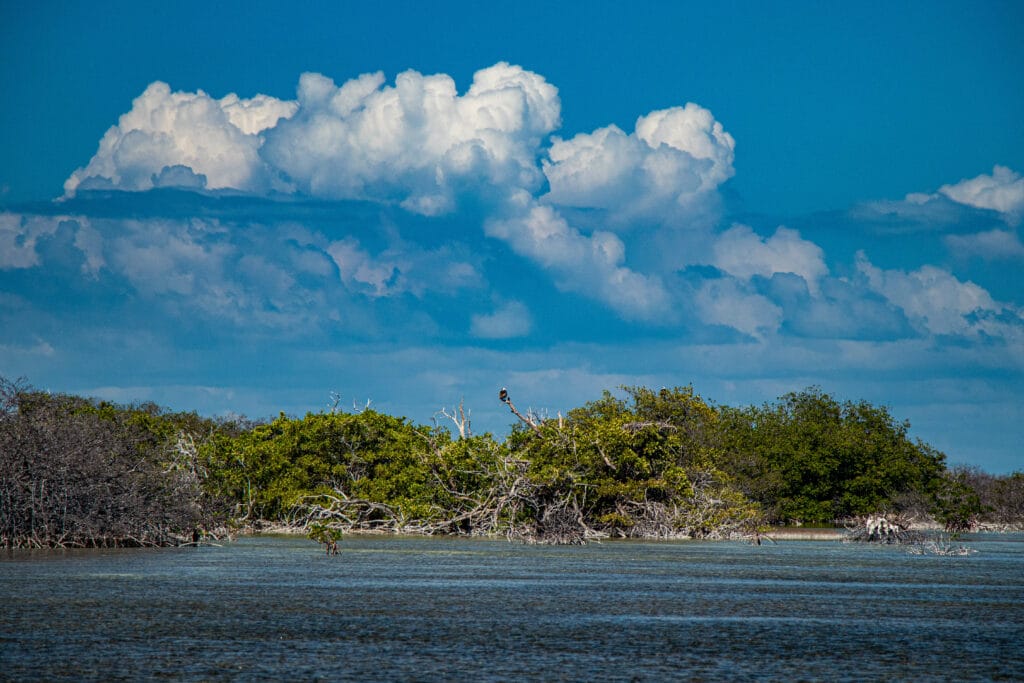
Returning to the mothership, we were greeted by Fishing manager Tony and Suli. All guests provided with a cold refreshing flannel whilst the rods are rinsed off and placed into the dedicated holders. Venturing up to the sun deck, a busy production line of mojitos and freshly baked pizza fuels the fishing tales of the day just gone, with everyone happy with their first day on the water. As the sun descended on a lovely day, several large imposing storm clouds rolled in providing a spectacular apocalyptic night sky. A heavy deluge of rain was ignored as we tucked into fresh lobster tail and jack cerviche.
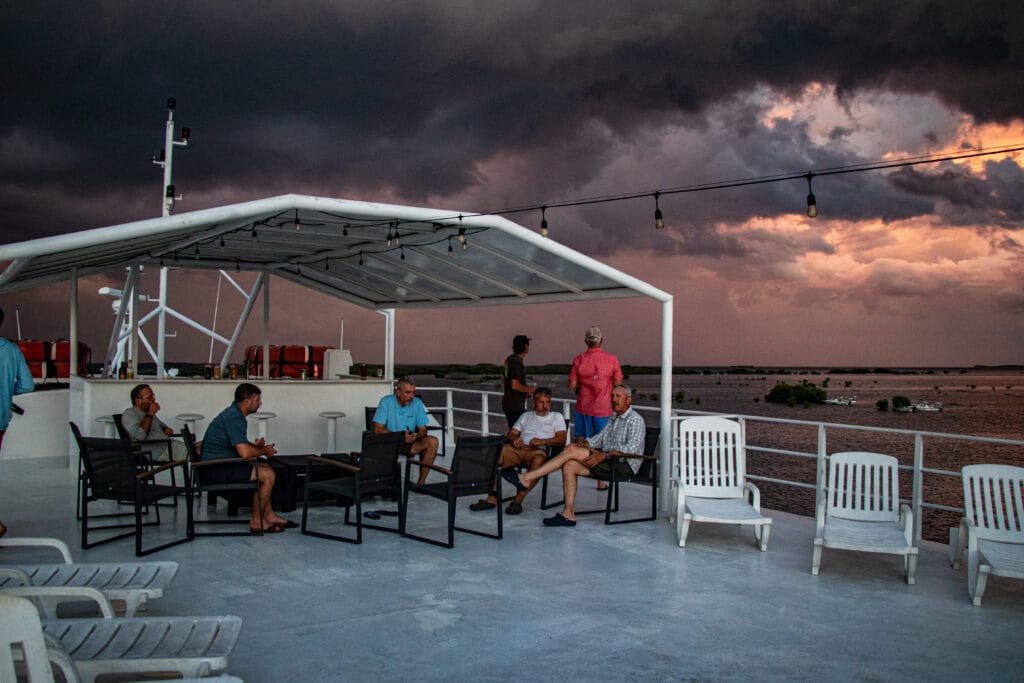
The rain was a distant memory as I headed for my morning coffee in the darkness on day 2. The night sky littered with twinkling stars. The wind had definitely strengthened slightly, and as light began to spread it was possible to see that the direction had changed, now pushing for the southeast rather than the prevailing north easterly that they enjoy here. Today we switched up and I joined forces with Mark and guide Raudel.
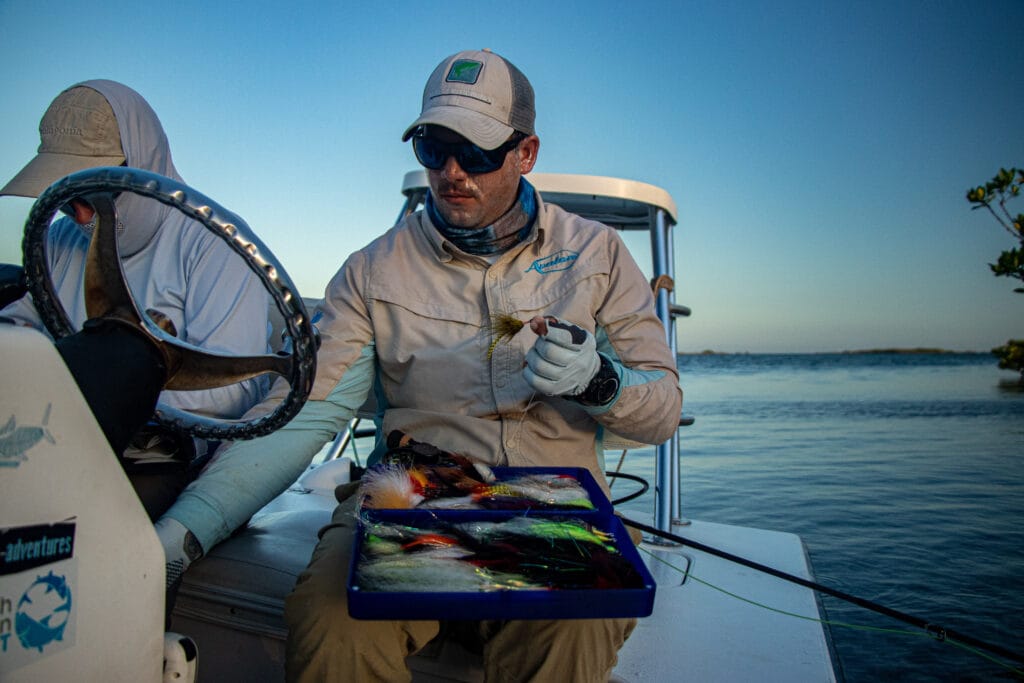
Taking to the water we gave the tarpon a go in the mangroves first up in the gloomy light and despite seeing fish and making good casts we had little success. In need of some more action, we headed back out to the large turtle grass flats to chase skinny water bonefish. The dropping tide had the fish nervously clinging to the flats. Our approach had to be quiet and flies with little weight. Mark and I had some action in between regular school blowouts if there was a wave that caught the boat to loudly or cast that landed too close.
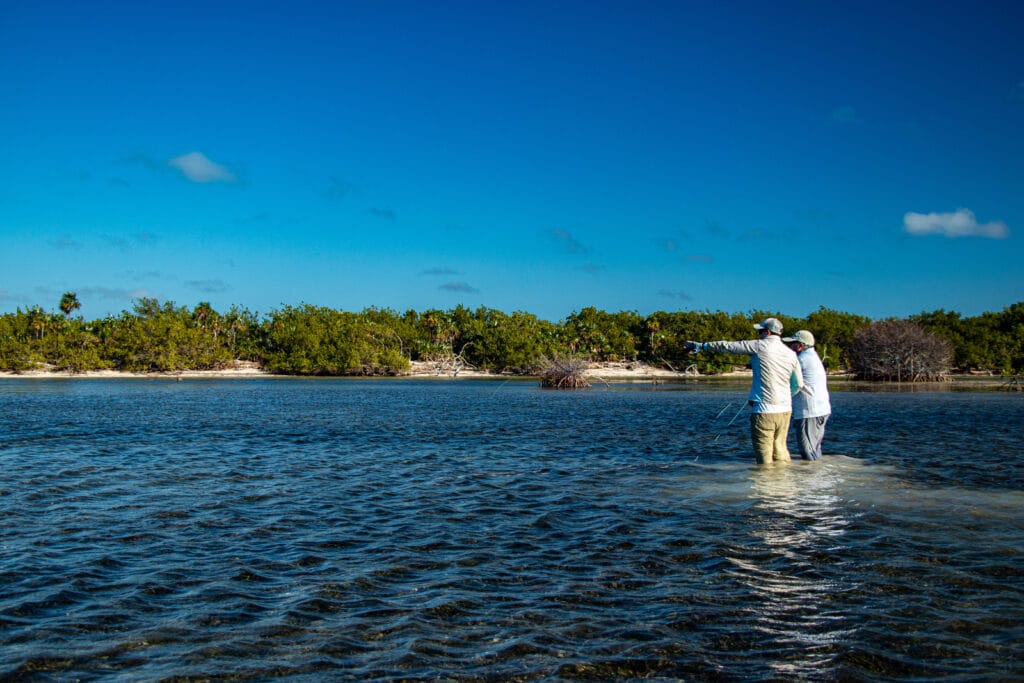
Looking to make the most of the shallow water, we did hop out of the boat and trudge through the soft sand. Mark worked a large school of good-sized bonefish and I walked away into the wind to see if I could find any outliers. After a short while of carefully stepping my way, I spotted the tail and dorsal fin of a very large bonefish nudging its way through the now floating ends of turtle grass. The distance at first was just too much to place my excited casts. Positioning closer, I was able to get a reasonable cast out and saw the fish change direction to inspect my fly. A couple of heart stopping moments went by as I wait for the steady draw of the take… but it never came, and I watched the fish slide into the deeper water and disappear! Always easy to say these fish were huge, but I would not have been surprised if it was in excess of 10 lbs.
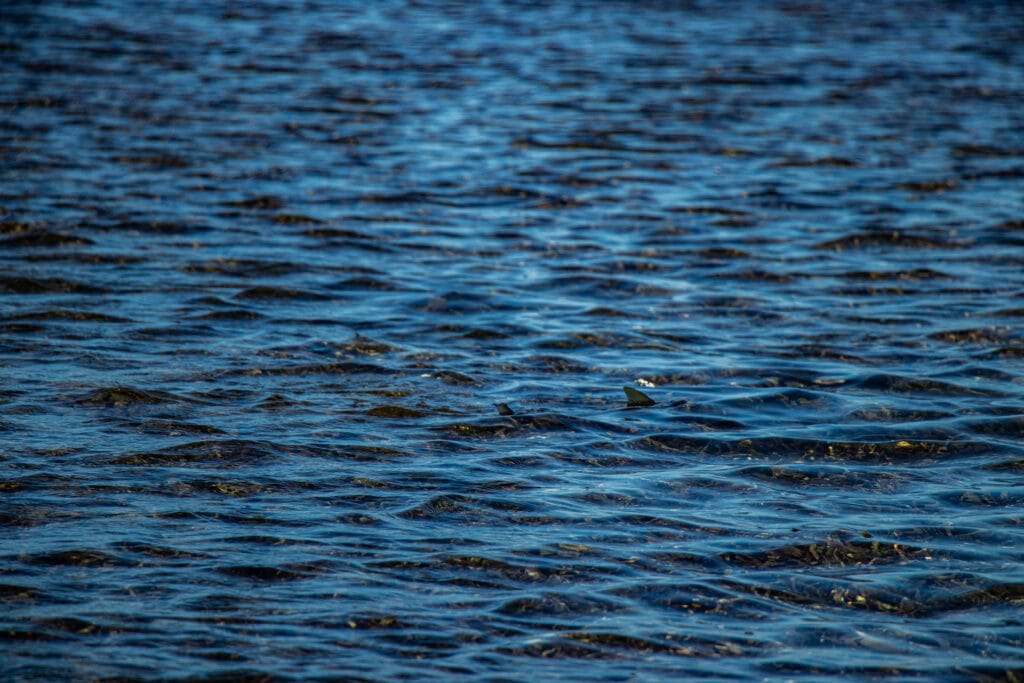
Now with the bonefish scattered and the tide at low, we hopped back into the boat and gave another flat a once over which produce a good but unsuccessful permit shot. Followed by nudging into a mangrove hole to look for tarpon before lunch. In these small nooks and crannies, the guide will push the boat in and use the pole to make a crashing noise. This resembles the sound of the diving pelicans. If successful, this then causes the tarpon to glide out from the mangrove roots to inspect their next potential meal. This ploy worked, and after a couple of shots I jumped a reasonable baby tarpon, only to see the fly ping through the air mid-jump.
The afternoon brought with it the pushing tide and a chance to target permit and tarpon on the southern flats. This time we had both rods at the ready in the boat. Our guide Raudel had pondered the Fulling Mill Avalon Shrimp on my permit setup before cutting it off and selecting a Fulling Mill Tan Flexo. Working our way along a long flat, Mark was up first, and several permit shots posed themselves, but again the fish were rarely where we needed them to be or they were simply moving too fast. Rather than being deterred, we ran back up to the top of the drift and worked the flat again. Mark insisted I had a go, so taking the bow I scanned the water in front, again a couple of single permit flew by without much opportunity.
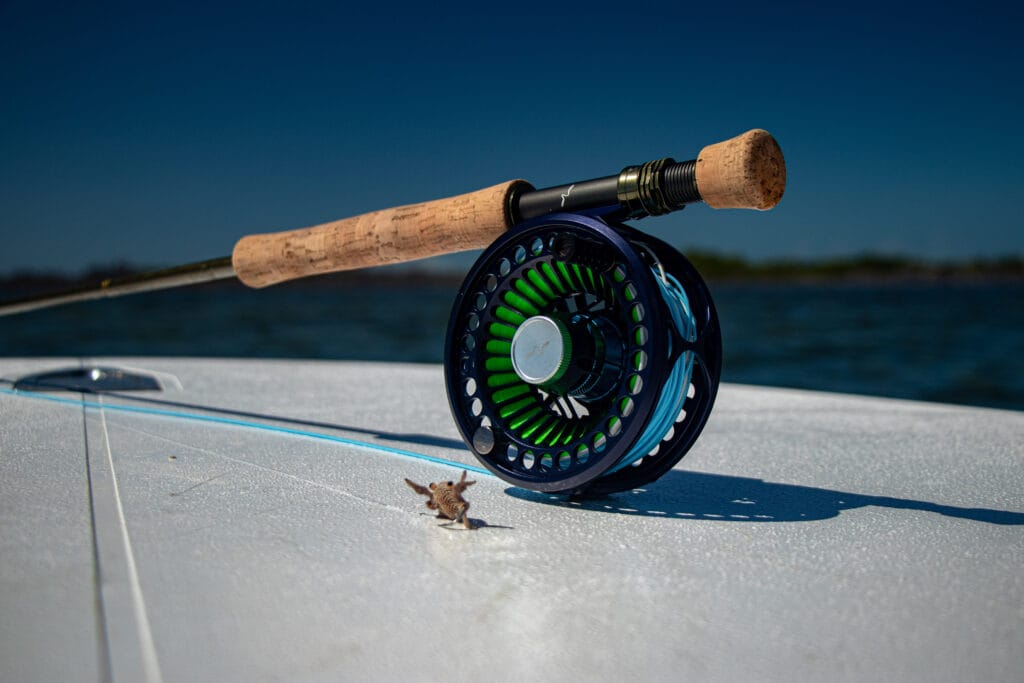
Nearing the end of the flat, suddenly Raudel excited called out directions “1 O’Clock! 60 feet!”. Eyes trying to catch any movement, I caught glimpse of several black tails hurry from right to left. As they reach the optimum 11 O’Clock area for a right hander, I made the cast. The lead fish showed no interest at all, but within the blink of an eye a smaller fish sped up and engulfed the crab pattern. Somehow holding my nerve, I gave a long strip to secure the hook. Now attached, it peeled away from the school and headed for the horizon along with a considerable amount of backing! The fight from a permit is special, and even though this one was not huge it certainly kept pulling for a long time. I was delighted to land the fish and, it was great to share the moment with Raudel and Mark.
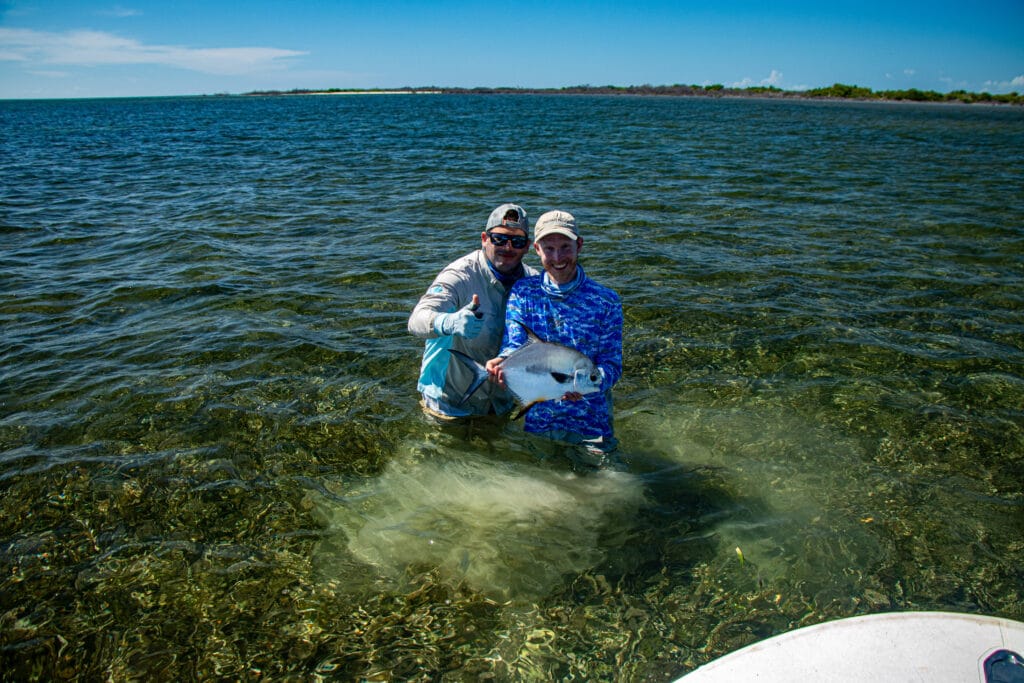
Before we could continue our quest to find Mark a permit, our boat’s engine required some attention from the ship’s mechanics, but it did not take long. The next couple of flats threw up passing permit shots with little chance to get the fish to pause and look at a fly.
As the sun descended lower in the blue skies, I could sense Raudel getting twitchy that time was running low to try and achieve a Grand Slam. A brief game plan discussion in boat and we gunned the engine back towards the mothership and into the mangrove channel where our day began. With eyes pinned on the dead mangrove roots we waited for any signs of tarpon. Periodically we could see rolling fish deep in the flooded snags. After one or two plunges of the pole, several tarpon came close to the opening to see what was happening. It was now or never. I made the short cast with an Olive Poon Bug. Just one long strip and the bucket mouth of a small silver king engulfed the fly. Several hair-raising jumps and numerous close encounters with snags kept us all holding our breath. Finally, we had the Grand Slam completing tarpon resting at the side of the skiff.
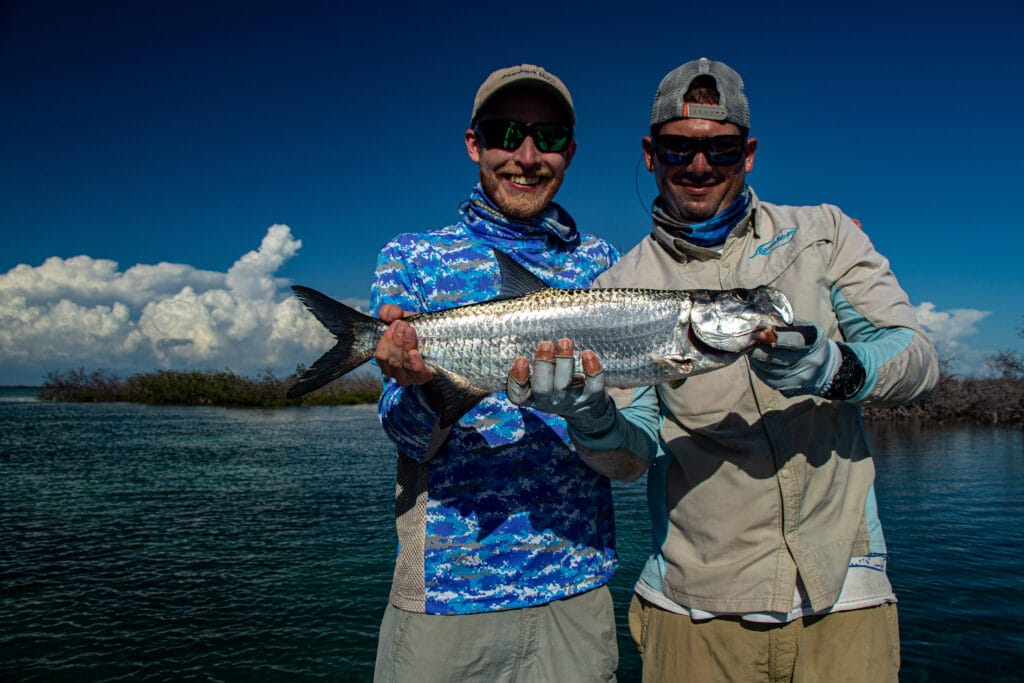
That evening we enjoyed more good food, cold drinks and stories. We even threw some casts off the back of the boat, where fish could be seen crashing bait just outside of the spotlight reach, this became a nightly obsession with success increasing as the week went on.
The early morning coffee brought with it the spectacle of tarpon feeding on baitfish right at the back of the boat. I’d like to say it seemed too easy to cast to them, but maybe I didn’t want the embarrassment of not catching one… so I stuck to my breakfast instead.
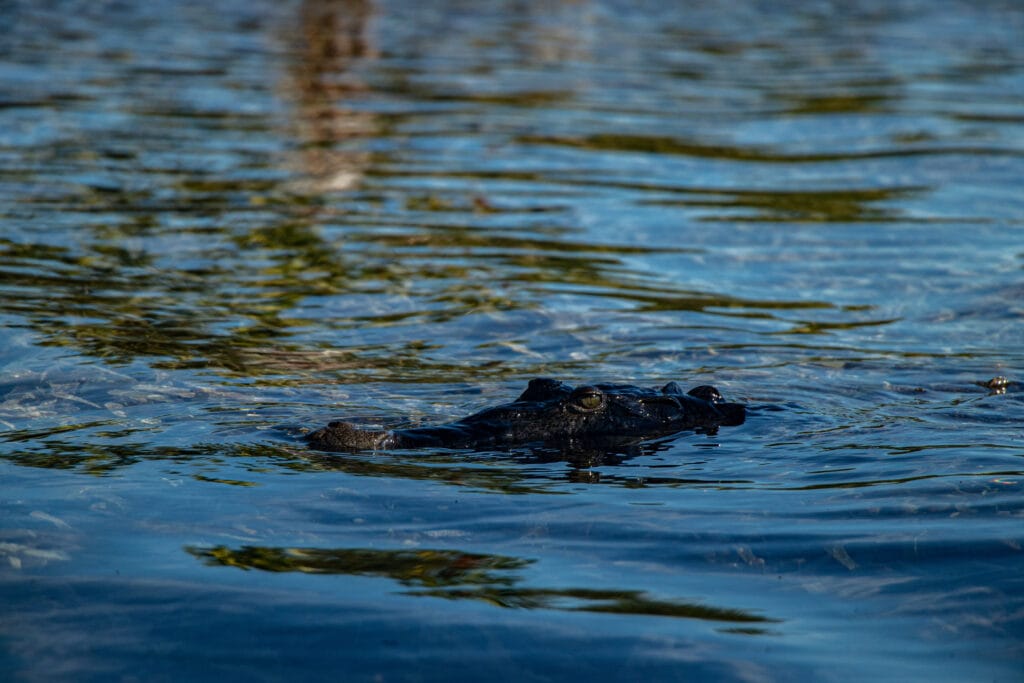
Returning to the water with Raudel and now Ezra, the winds had begun to swing back, now blowing from the east. Although, the winds from the day before had caused the swell to pick up on the southern flats. This made spotting permit difficult in choppy and slightly coloured water, but as they say, when one door shuts another opens… We headed west from our mooring to settle on a southern-facing beach flat. The sandy bottom had been churned up and a huge shoal of sardines had been washed in to create a sardine chowder, much to the enjoyment of the Cuban tarpon and yellow-tail jacks. For a couple hundred yards it was possible to see little sardines skip and hop from the water, and then every now and again dozens of them would spray into the air followed by the impressive silver roll of a pursuing tarpon.
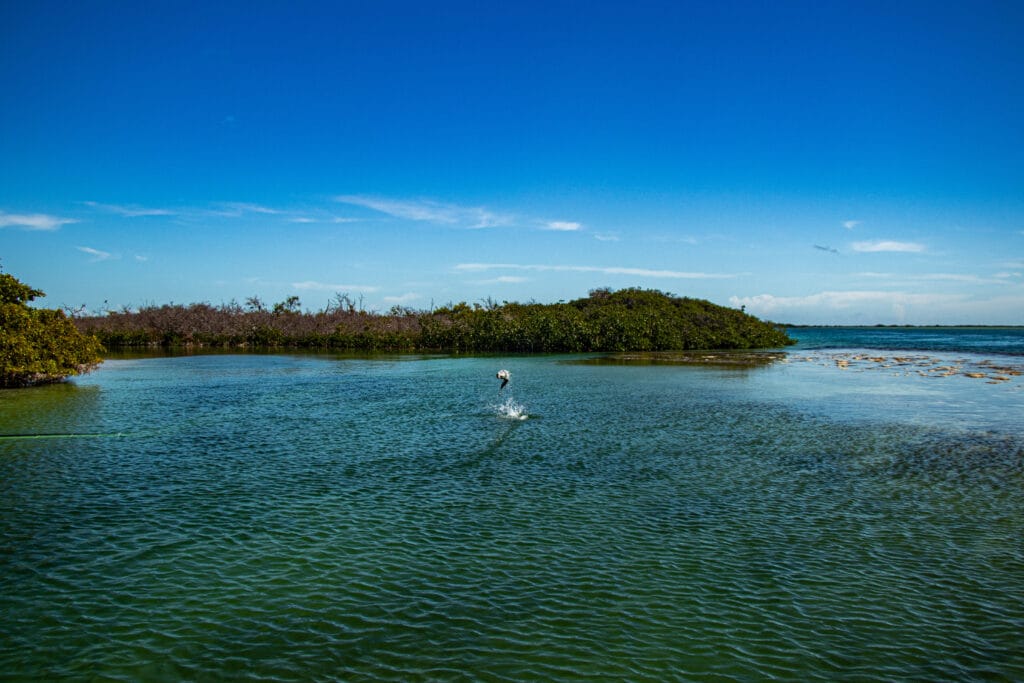
Despite the feeding frenzy in front of us, we were unable to get a tarpon to select our fly in the mix of baitfish and coloured water on this occasion. We therefore headed into the mangroves to look for smaller schools of tarpon in clear water. The first group we found, were always moving away from us making it challenging to get the fly in front of them. Across the small channel though, we spotted a larger group of fish in a great position. It was here that Ezra landed his first silver king and jumped a second. I too had brief encounters with two tarpon, but only to see my Tan Toad by Fulling Mill get shaken free in mid-air during wonderful acrobatic leaps.

Ezra was now fully hooked by the tarpon bug, so after a quick lunch pitstop we headed back out to the oceanside flats in search of bigger tarpon. Poling the expansive flat, the water again slightly cloudy. Our eyes scanned the water for any movement, and then out the corner of the eye, a flash of silver and black as a tarpon rolled. We moved the boat closer, looking for the next glimpse. Unable to spot the fish Ezra made several blind casts in the direction that we spotted the fish. With long steady strips, we anticipated a fish at any moment… almost any moment! As a good tarpon smashed the fly at the edge of the boat, shocking us all… and sadly resulting in no hook up.
Undeterred we continued to scout the area. It was not long before another tarpon rolled, predicting where it was headed, Ezra made the cast. This time using a small traditional Cockroach. The long strips were interrupted, followed immediately by the water exploding and a silver king taking to the air. Several more jumps came quickly before the fish began making long runs, a sign of a bigger fish to the ones we had encountered in the mangroves. The fish gave both the angler and the 10 weight setup a good workout, and despite several nervous lunging runs close to the boat, Ezra and Raudel landed a fine tarpon.
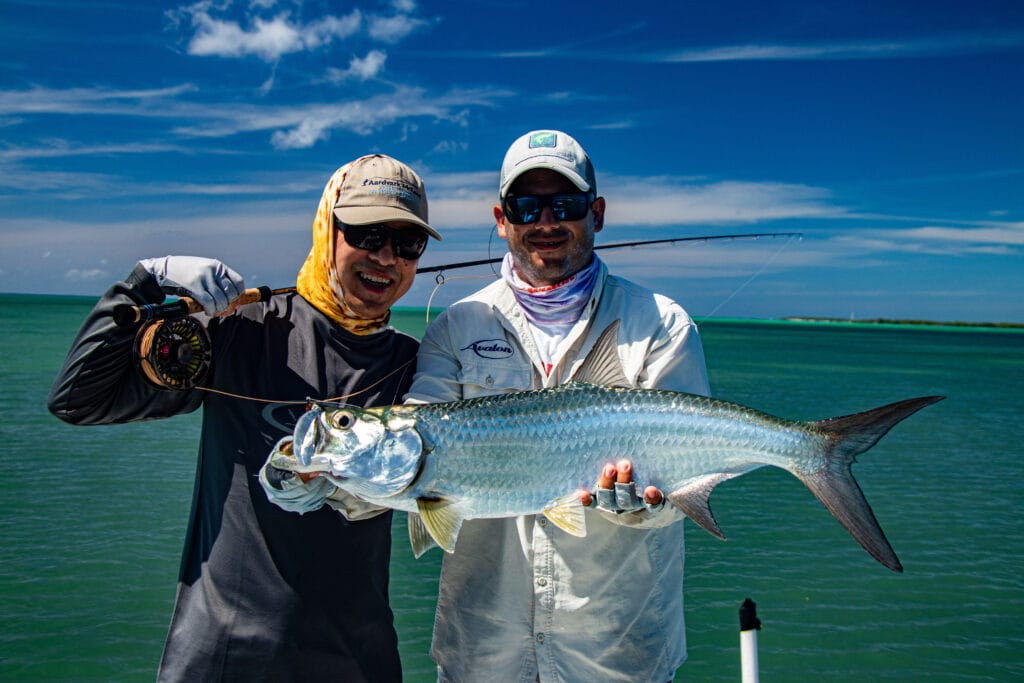
As the afternoon pressed on, we had fleeting shots at two permit before setting on the big bonefish that were working the shallow edges along exposed patches of turtle grass. The fish were moving slowly between small gaps in the grass with their dorsal and tail fins sticking out of the water, almost like a small shark. Fishing a small Fulling Mill Cuban Shrimp proved most fruitful, with the bonefish visibly charging the fly down through the grass. Once hooked the fish tore off into the open channel, and with the dropping tide causing the channel to run like a river the fish’s impressive power was doubled as you were also fighting the current. We landed three bonefish quickly up to 5 lbs in a fantastic half hour of action and then it was time to head back to the mothership for mojitos and Italian night!
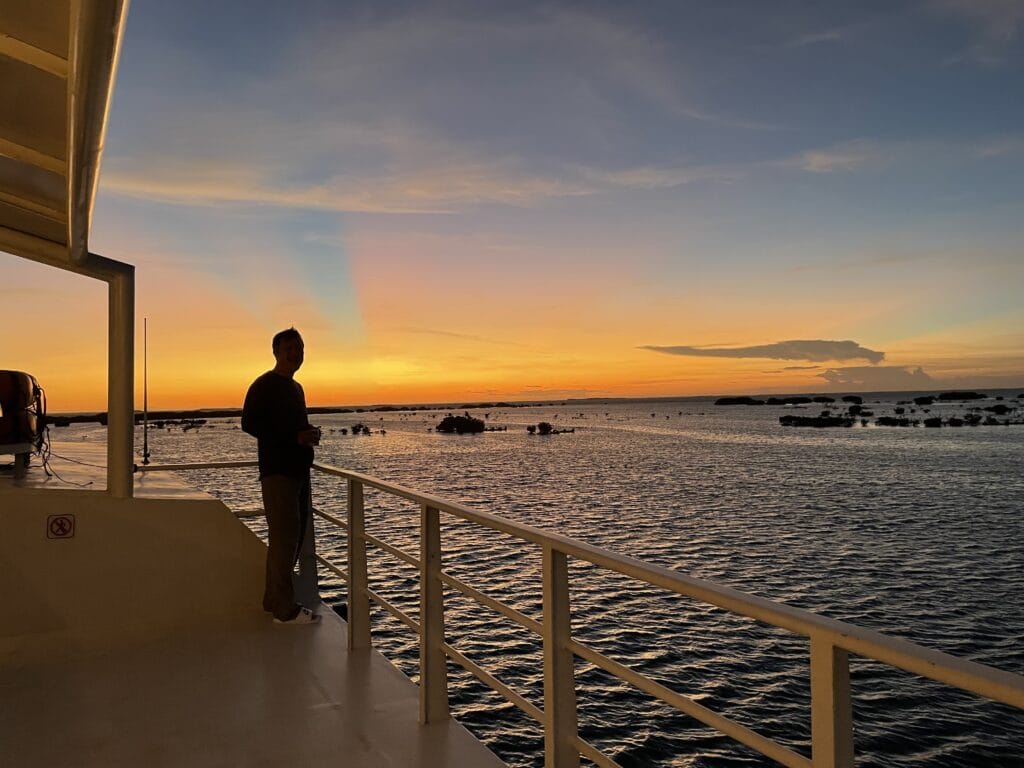
Now over halfway through the week, the whole group had had a good chance to explore the fishery and the fishing on offer and were able to be more focused with their preferred areas and species to target. For this day I headed out on the water with Simon and veteran guide of the area, Titi. With the wind blowing a little stronger and some morning cloud around our first location was a small mangrove channel for tarpon. The water rippled slate grey and silver, all of a sudden, several tarpon could be seen rolling through the broken water although incredibly difficult to see. Twice the fly landed in the right place, only for a small snapper to grab a hold instead. Before long, the school of fish slid off into the mangroves and the opportunity was gone.
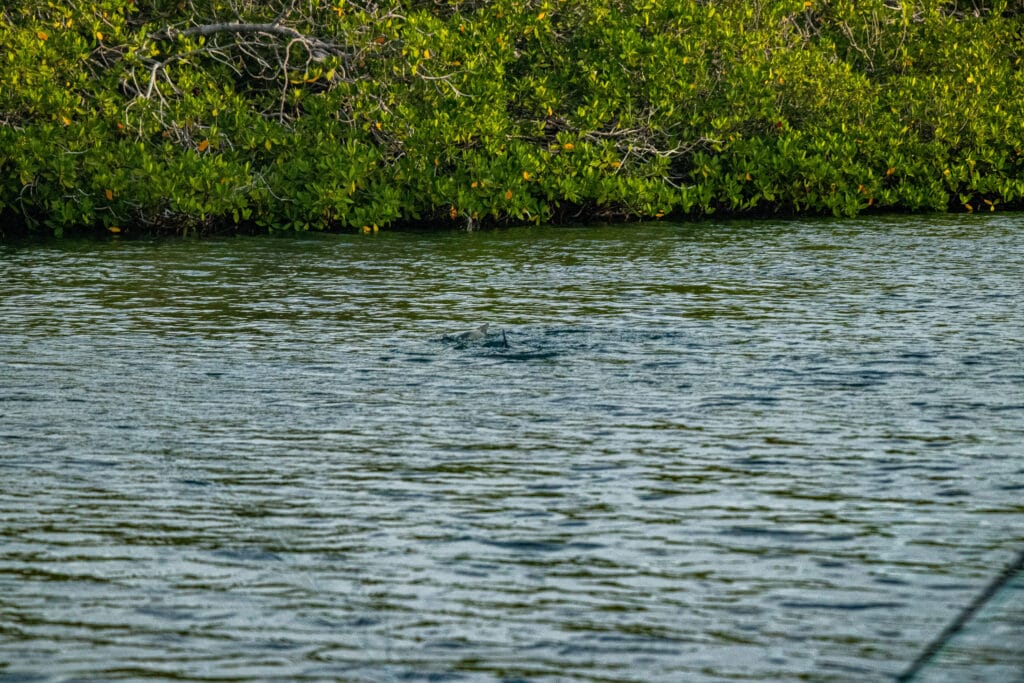
Heading to the outer flats we were met by strong winds against the tide which made the boat difficult to control and the fish hard to see. The drifts went quickly, and the combination of high speed and tricky spotting conditions meant that several possible permit shots had already passed us before any reasonable shot could be made.
A change of plan was formed, and we headed inside the mangroves to a series of luscious turtle grass flats in search of big bonefish. The wind was still troublesome, but we were able to find a number of lone and small groups of bonefish feeding. Getting a cast out was tricky in the rough water the bonefish were coming right to the boat’s edge. I managed to hook one about 10 feet from the boat before Simon hooked into a lovely fish that had his line zipping across the flat. A size 8 Cuban Shrimp was definitely appealing to these fish.
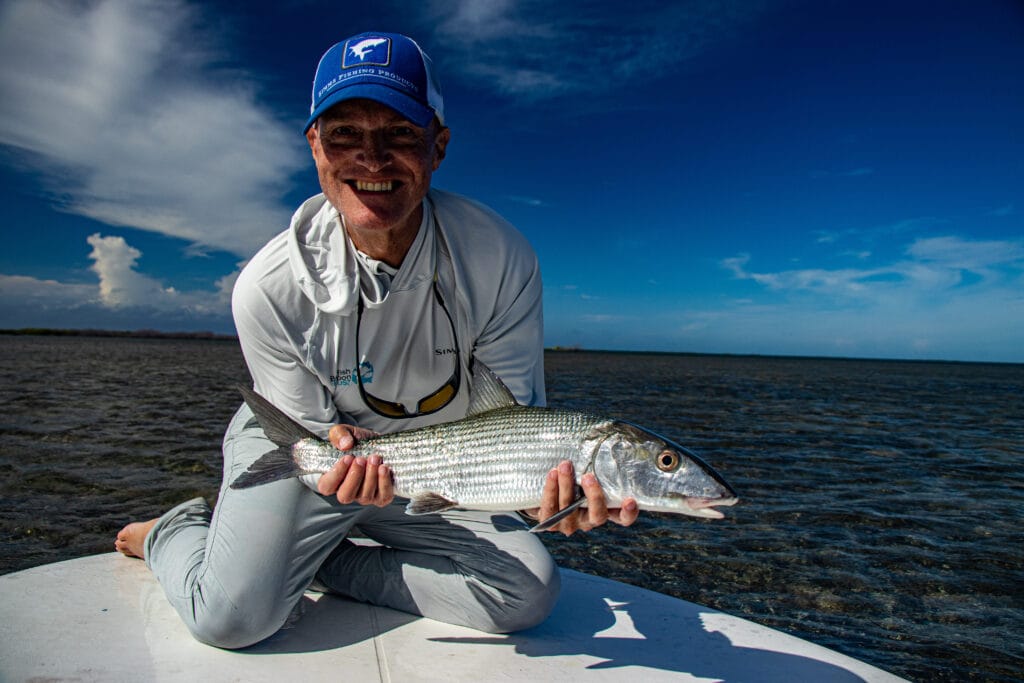
Having had some success, we decided to stop for lunch. Titi motored us into a sheltered copse of mangroves. As we chatted away and ate lunch little paws inched along the mangrove branches. A family of Desmarest’s Hutias had come to investigate. The stout mammals gleefully devoured some lunch scraps before scuttling back into their woody lair.
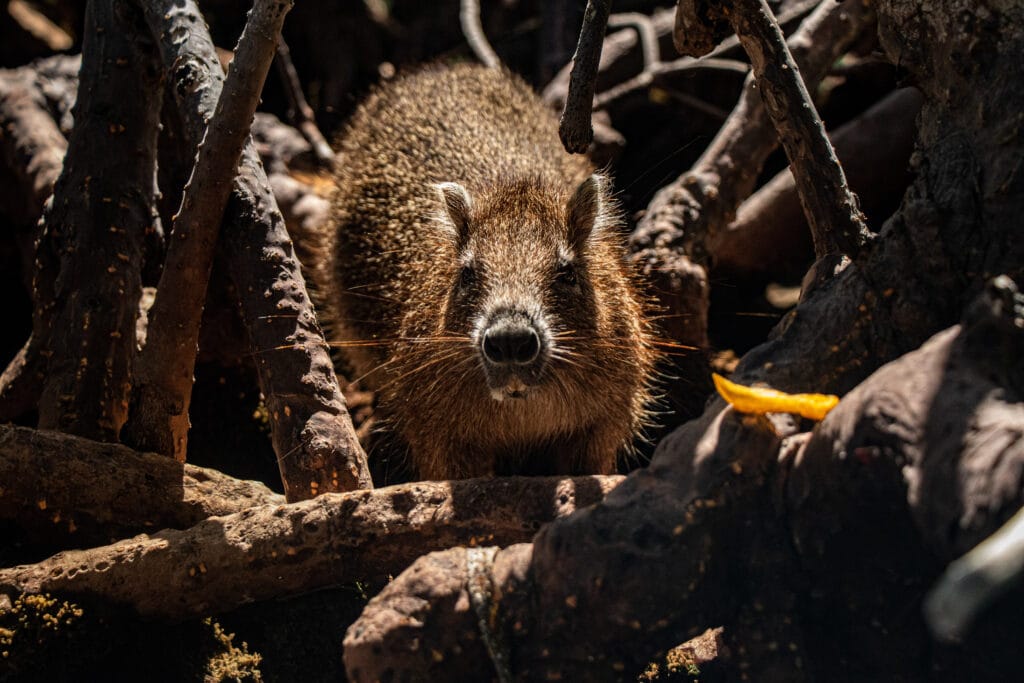
After the break we went way inside the fishing zone to fish some deeper mangrove lined flats for cruising tarpon. We had fleeting shots, but the fish seemed wary. Several smallish sharks also patrolled the area looking for their next meal. Apart from some small snapper and group in one of the channels we had little interest in our flies.
Changing tack, we put the tarpon rods away and took out the permit setups. Titi positioned the boat so that we worked several long flats, all of which were about 2-3 feet deep. The change nearly paid off as we located three single permit, two unfortunately bolted before we could cast, the third tailed happily for a while before it too headed off into the glare.
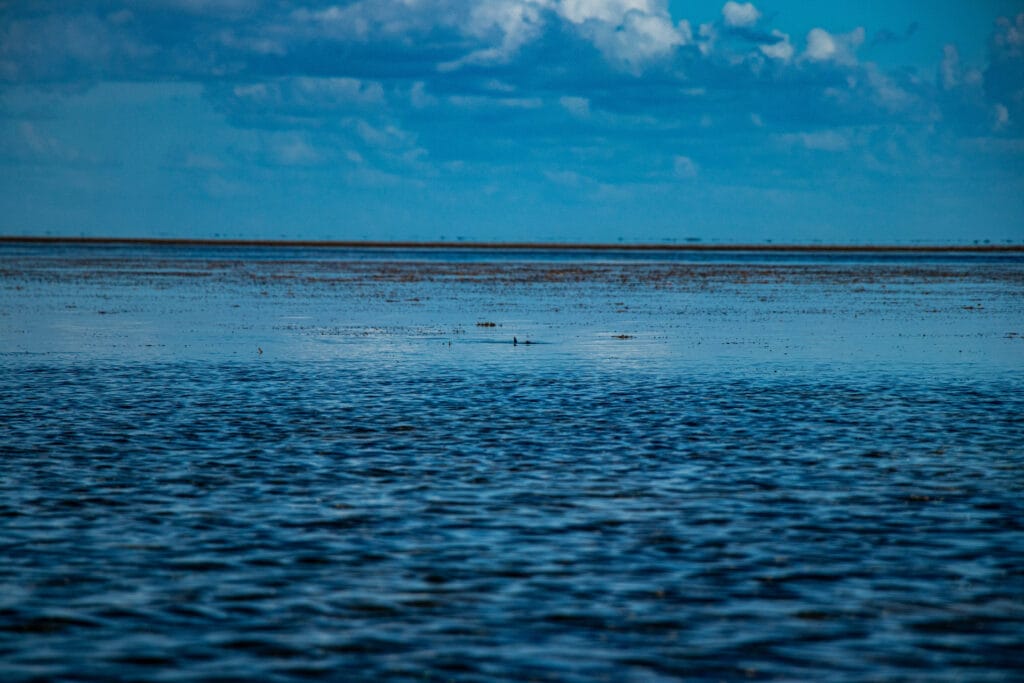
We finished the fishing day with a couple of tailing bonefish and a brief spell of excitement as we stumbled across a school of rolling tarpon almost right back at the mothership. Aboard the boat, the evening was another delight with ‘Grill Night’. Beef steak and lobster tails were barbecued and served with a range of sides included Yorkshire puddings!
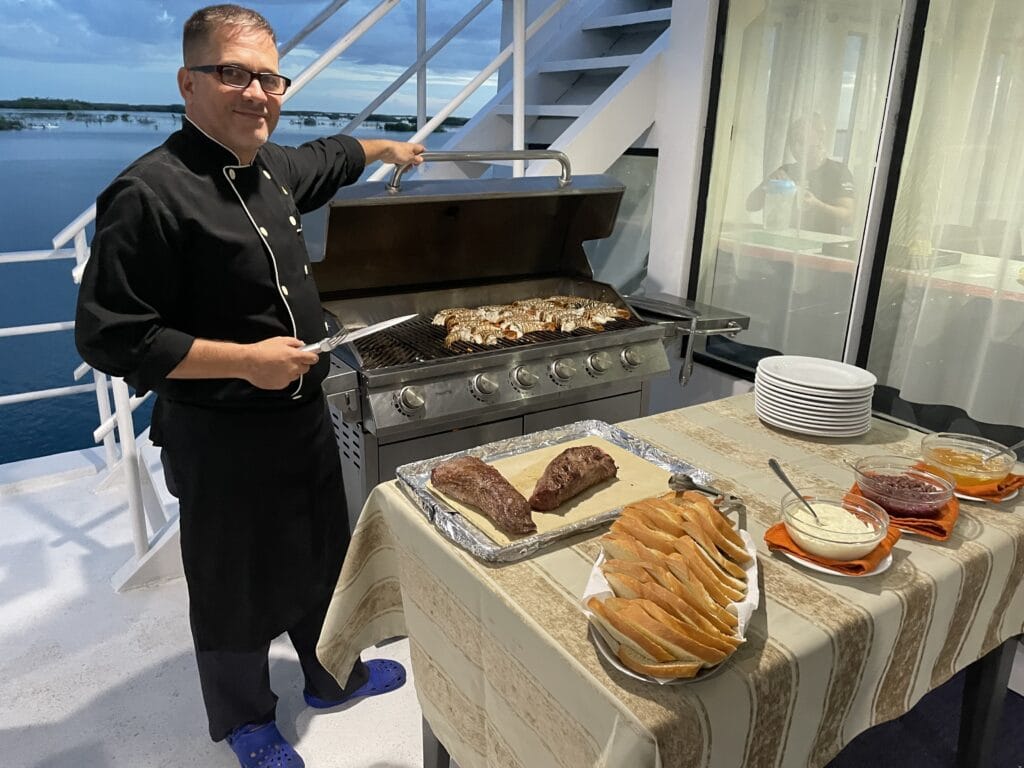
Awaking to another sunny morning, I took to the water, this time with Giacomo and guide Alexei. Utilising the low morning light, we went in search of rolling tarpon first up. As we poled along a beach edge merging into a mangrove lined channel there was suddenly an explosion of activity. A school of tarpon had started crashing into sardines trapped on the edge of a tide rip. In amongst the tarpon two huge jacks breached the water adding to the frenzied excitement. Sadly, we were not quick enough to capitalise on the commotion and our casts were met with little interest.
As the morning progressed the story of near misses and ‘if onlys’ continued. Firstly, we were working a flat in search of permit, eyes scanning the mix of sand, coral, and turtle grass. Somehow, a school of 20 or so permit snuck into range undetected. By the time a cast could be made the lead fish were already beginning to scatter, quickly joined by the rest of the group. Then as we pulled up alongside Stephen and Harry at lunch, we heard tales of woe as both had had eats but no hook-ups with permit that morning.
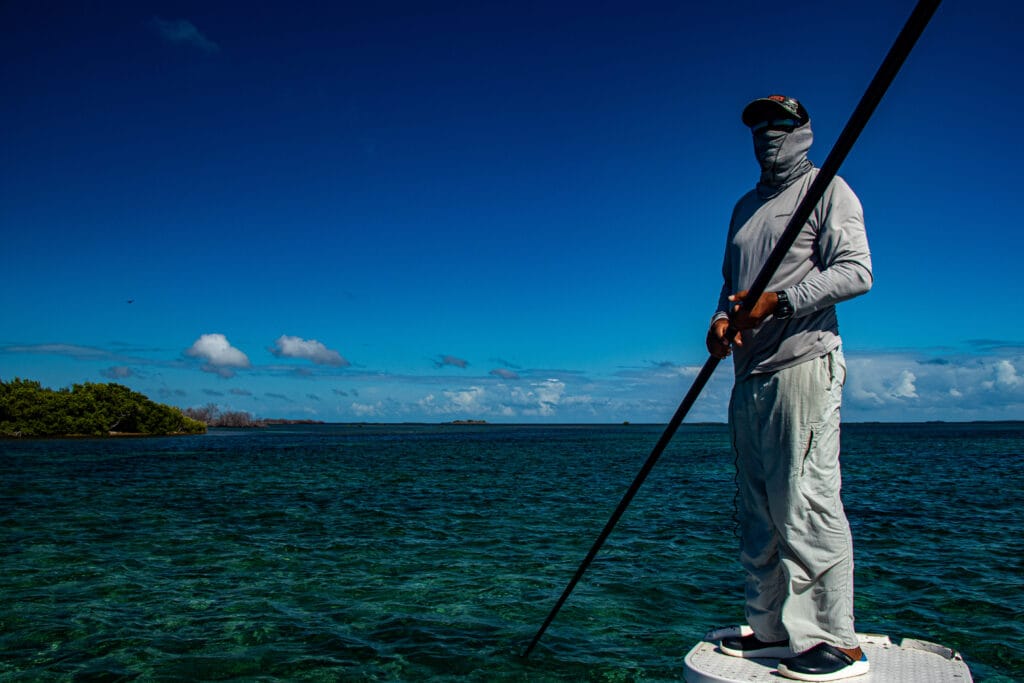
The afternoon kicked-off in similar vein, drifting a flat we spotted what looked like two black blades of turtle grass twisting sub surface in a small patch of sand. A harder look allowed for the body of a happy and hungry permit to be made out. It was rummaging on the bottom for tasty crustaceans. At 9 o’clock from the boat and just 40 feet away, we were presented with a great opportunity. Giacomo made the cast, but on the fly’s landing the fish sensed the noise and scuttled away.
Our successes finally changed when we moved onto two large schools of bonefish on the edge of the turtle grass. We landed five good-sized bonefish in quick succession, the biggest being around 6 lbs. All coming to heavy-eyed shrimp patterns to allow for the fly to get down in the deeper edge of the turtle grass.
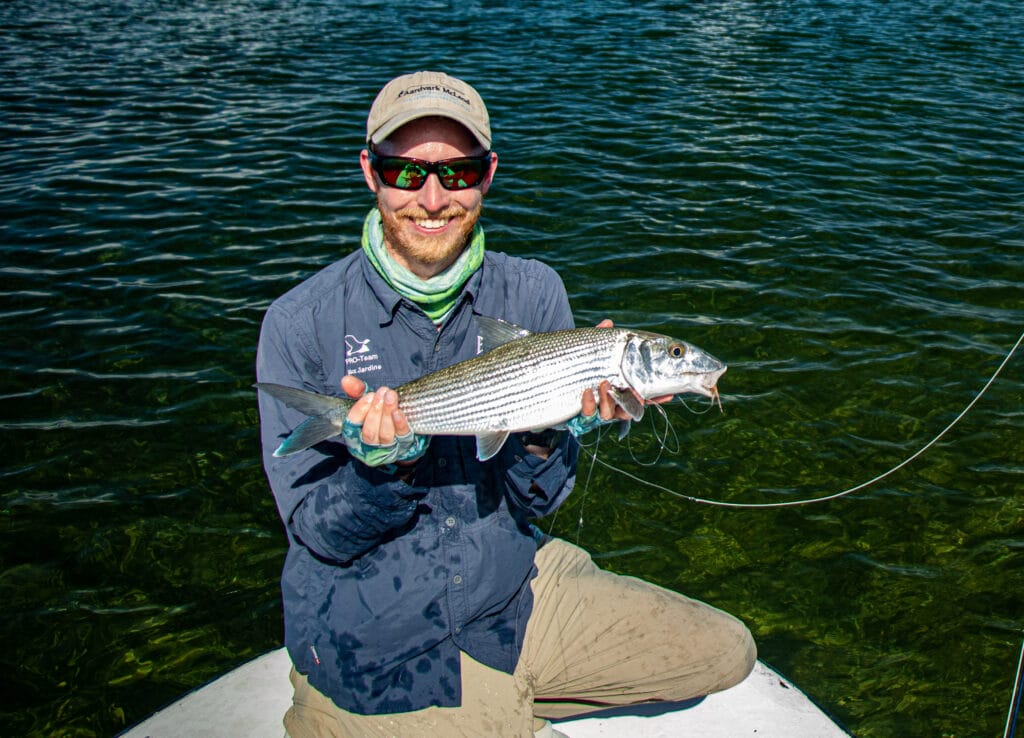
We could have fished on but as the end of the fishing day was neigh, several storm clouds were gathering and merging, so we made the call to try and outrun the rain back to the mothership. Arriving just in time back at Jardines Avalon III, the horizon disappeared as a torrential burst of rain began.
At the evening bar debrief, we heard stories of some of the guys having fun fishing for tuna on the reef edge, and a couple managed to spot and snorkel alongside three whale sharks. As the stories continued into the evening, the rain cleared, and we were blessed by a beautiful sunset. The perfect entrée to Cuban Night!
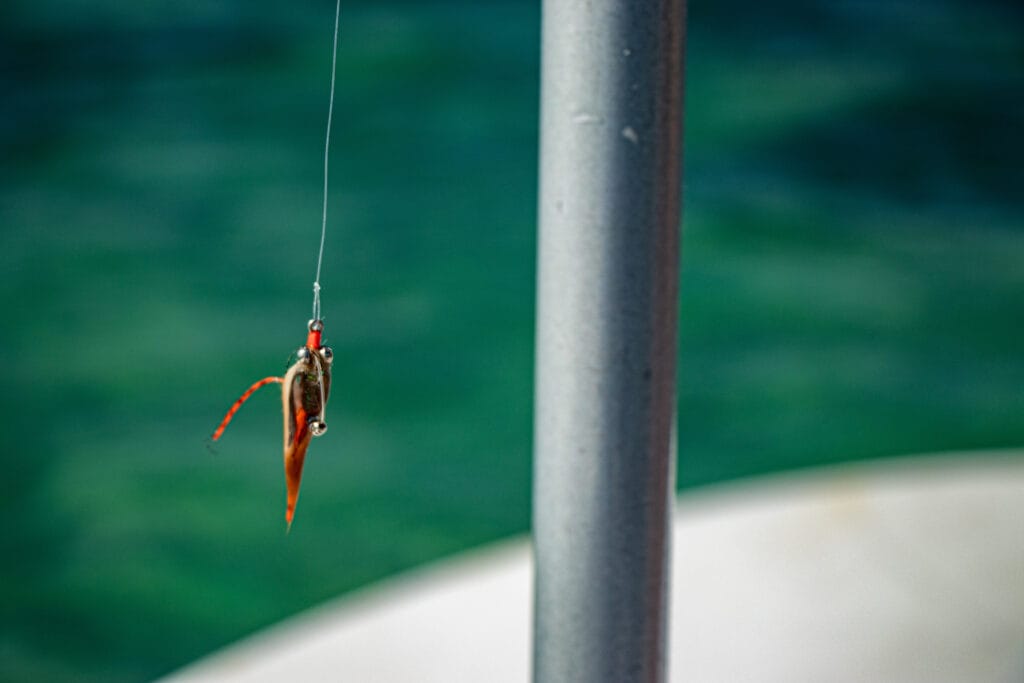
Our final flats day was upon us, time moves so quickly on these trips and the end was insight. The final fishing day on Jardines de la Reina trips is a half day on the flats as you return to port that evening. Looking to have one last hurrah, I headed out on the flats with Mamo and guide Alejandro. The weather was changing, with more cloud cover and wind causing a gentle chop on the water. Despite this, visibility was still good.
Looking to make the most of the final session, we began with a permit hunt along several beach flats but with little luck. Alejandro then motored us into a large mangrove lagoon, stopping at a point in the mangroves which at first glance was an impenetrable thicket of branches. Nosing the skiff in through the branches we emerged into a small secret lagoon. The water was clear but heavily stained with mangrove tannins. Almost half of the lagoon was glistening with huge shoal of sardines enjoying the refuge. There was one small opening at the far end, large enough for tarpon to silently cruise in and snaffle the baitfish. We had a brief window when the tarpon came out into open water, but they quickly retreated into the dense mangroves where we could hear them gorging on sardines out of reach!
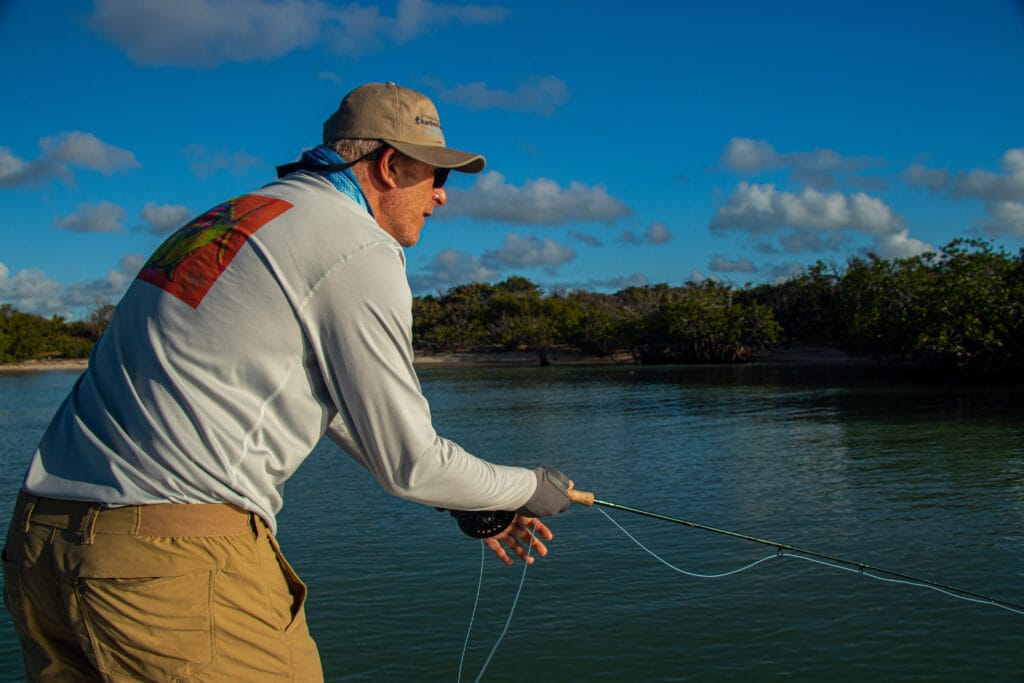
Back out on the flats we had a good shot at two permit as the shuffled across a flat close to the drop-off, and finished up with a solid bonefish. As we packed up and began motoring back to the mothership, we could see one of the skiffs going further and further off the flats, clearly in pursuit. We later found out that one of the group, Paolo, had hooked into and landed a nice permit with what would be his last cast of the trip.
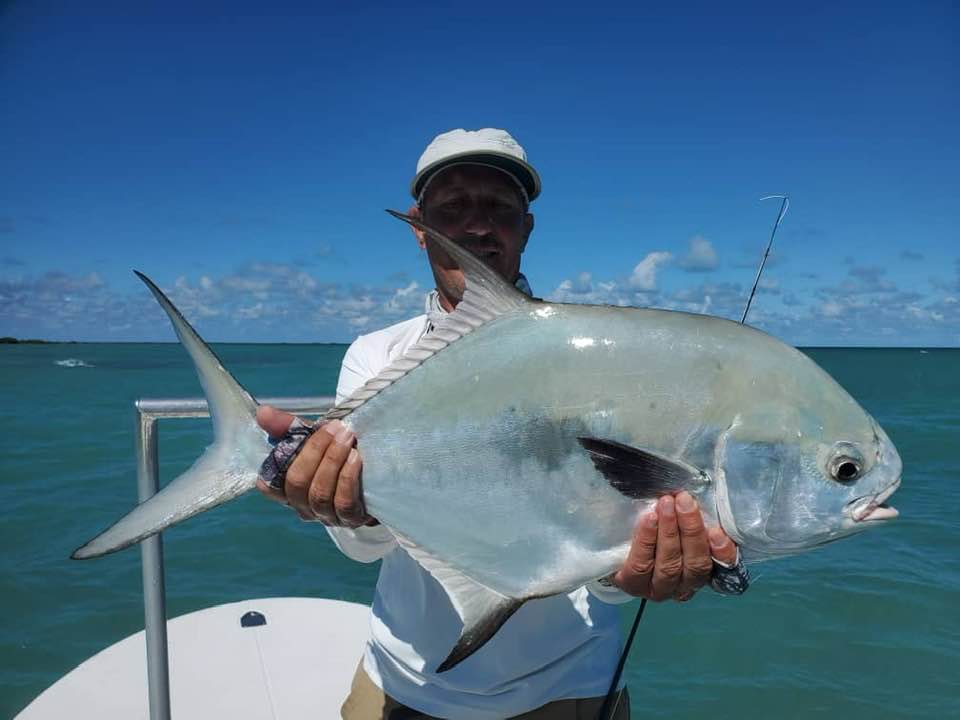
The afternoon we had a chance to wash down kit and pack away before Jardines Avalon III pulled up anchor and began the journey back to port. The gentle sail with warm breeze was a lovely setting to enjoy beer and mojitos and watch the sun sink down below the horizon. On reaching port we waved farewell to the wonderful guide team and sat down for our last meal onboard.
The following morning, breakfast kicked off at 0600 and we were packed and loaded onto our bus by 0700 for the road journey back to Havana. By this point most of the group used the time wisely to catch up on sleep. We then had a brief spell back in Havana to grab lunch and a few last minute souvenirs and then it was back to the airport and the journey back to reality.
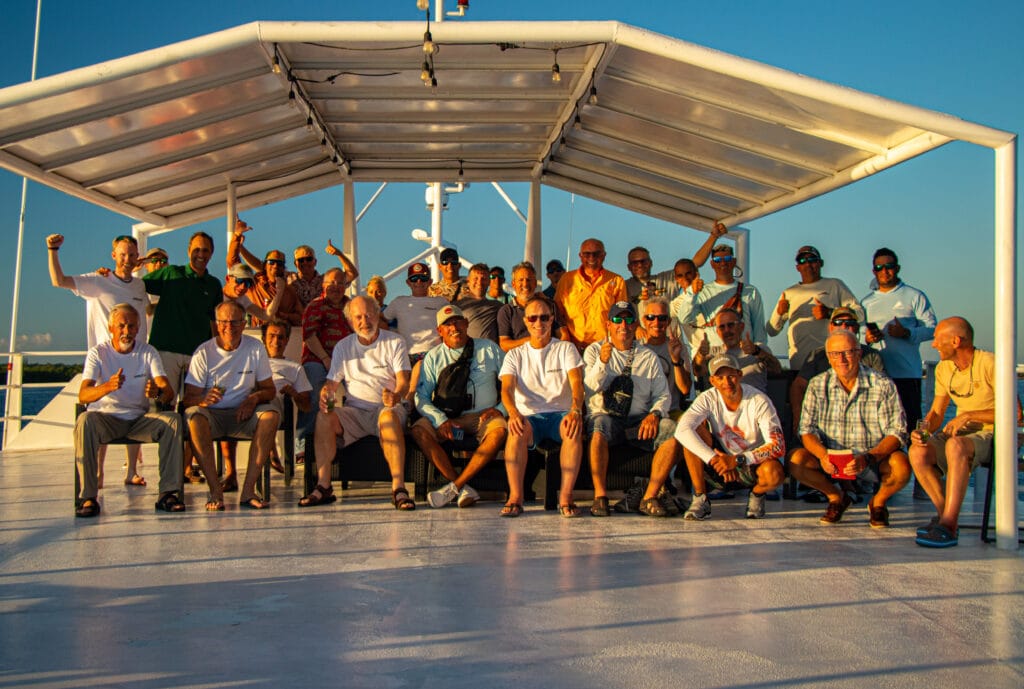
For more details about Jardines de La Reina, Alex’s next hosted trip or Cuba in general please do not hesitate to contact Alex Jardine or Peter McLeod, alternatively call our office on +44(0)1980 847389.

